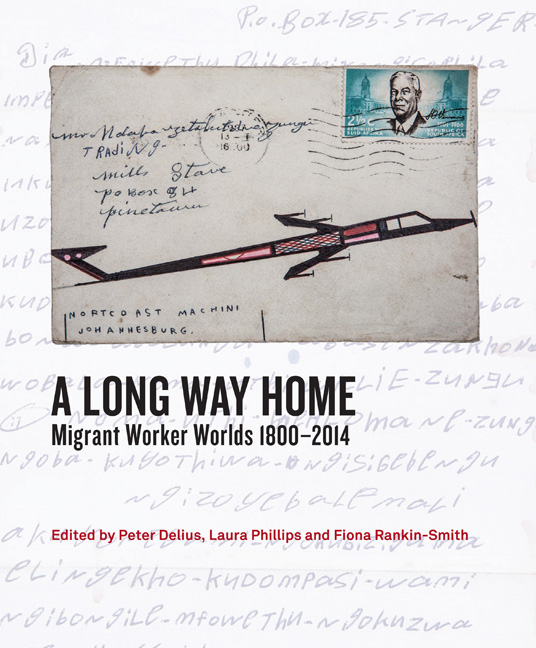Book contents
- Frontmatter
- Contents
- Acknowledgements
- Introduction: Highlighting Migrant Humanity
- Chapter 1 Ngezinyawo - Migrant Journeys
- Chapter 2 Slavery, Indenture and Migrant Labour: Maritime Immigration from Mozambique to the Cape, c.1780–1880
- Chapter 3 Walking 2 000 Kilometres to Work and Back: The Wandering Bassuto by Carl Richter
- Chapter 4 A Century of Migrancy from Mpondoland
- Chapter 5 The Migrant Kings of Zululand
- Chapter 6 The Art of Those Left Behind: Women, Beadwork and Bodies
- Chapter 7 The Illusion of Safety: Migrant Labour and Occupational Disease on South Africa's Gold Mines
- Chapter 8 ‘The Chinese Experiment’: Images from the Expansion of South Africas ‘Labour Empire’
- Chapter 9 ‘Stray Boys’: The Kruger National Park and Migrant Labour
- Chapter 10 Surviving Drought: Migrancy and the Homestead Economy
- Chapter 11 Migrants from Zebediela and Shifting Identities on the Rand, 1930s–1970s
- Chapter 12 Verwoerd's Oxen: Performing Labour Migrancy in Southern Africa
- Chapter 13 ‘Give My Regards to Everyone at Home Including Those I No Longer Remember’: The Journey of Tito Zungu's Envelopes
- Chapter 14 Sophie and the City: Womanhood, Labour and Migrancy
- Chapter 15 Bungityala
- Chapter 16 Migrants: Vanguard of the Worker's Struggles?
- Chapter 17 Debt or Savings? Of Migrants, Mines and Money
- Chapter 18 Post-Apartheid Migrancy and the Life of a Pondo Mineworker
- Notes on Contributors
- List of Figures and Tables
- Index
Chapter 12 - Verwoerd's Oxen: Performing Labour Migrancy in Southern Africa
Published online by Cambridge University Press: 04 July 2018
- Frontmatter
- Contents
- Acknowledgements
- Introduction: Highlighting Migrant Humanity
- Chapter 1 Ngezinyawo - Migrant Journeys
- Chapter 2 Slavery, Indenture and Migrant Labour: Maritime Immigration from Mozambique to the Cape, c.1780–1880
- Chapter 3 Walking 2 000 Kilometres to Work and Back: The Wandering Bassuto by Carl Richter
- Chapter 4 A Century of Migrancy from Mpondoland
- Chapter 5 The Migrant Kings of Zululand
- Chapter 6 The Art of Those Left Behind: Women, Beadwork and Bodies
- Chapter 7 The Illusion of Safety: Migrant Labour and Occupational Disease on South Africa's Gold Mines
- Chapter 8 ‘The Chinese Experiment’: Images from the Expansion of South Africas ‘Labour Empire’
- Chapter 9 ‘Stray Boys’: The Kruger National Park and Migrant Labour
- Chapter 10 Surviving Drought: Migrancy and the Homestead Economy
- Chapter 11 Migrants from Zebediela and Shifting Identities on the Rand, 1930s–1970s
- Chapter 12 Verwoerd's Oxen: Performing Labour Migrancy in Southern Africa
- Chapter 13 ‘Give My Regards to Everyone at Home Including Those I No Longer Remember’: The Journey of Tito Zungu's Envelopes
- Chapter 14 Sophie and the City: Womanhood, Labour and Migrancy
- Chapter 15 Bungityala
- Chapter 16 Migrants: Vanguard of the Worker's Struggles?
- Chapter 17 Debt or Savings? Of Migrants, Mines and Money
- Chapter 18 Post-Apartheid Migrancy and the Life of a Pondo Mineworker
- Notes on Contributors
- List of Figures and Tables
- Index
Summary
There is a misperception that whatever is indigenous in African culture is ‘made in the village’ and then hybridised in the urban or industrial workplace. In this view, migrant labour has led to an attrition of an authentic culture. Deeper research has shown, however, that whatever might be identified as ‘African culture’ in southern Africa is as much a product of road and rail, the transport depot, the administrative and recruitment camp, the hostel, the tavern and the shanties as it is of any idealised rural setting. Such ‘cultures of mobility’ include well-established genres of musical poetry, folk narration and dance that express experience over migrancy's long history. Such genres represent a building up of performative repertoires as responses to working men and women's lives lived on the move. Centring on the sung poetry of Lesotho migrants, this chapter presents and analyses such repertoires not only as cultural archive, but as action; not simply something migrants know, but something they do.
Musical migrations
From the earliest history of migrant labour, returning workers brought with them the experiences and the conceptual and material artefacts of colonial life. Among these were ‘trade-store’ musical instruments such as the concertina, violin and guitar, popular both on farms and in towns in the Cape with troubadours of all races. Fascinated youngsters in the villages produced their own home-made versions. The importance of music to migrants is expressed in a well-known folk story about the concertina or ‘squash-box’. According to this account, Basotho men first adopted the German or Italian concertina as a means of producing the choral ground and responses to their own solo poetic singing on the trek to the workplace. On the long migrations by foot, often in rain or winter cold, the concertina was played close to the chest under the uniform woollen blanket worn by Basotho, pumping out warmth as well as musical accompaniment to the migrants’ long rhythmic strides and lyric vocal passages.
Prior to these importations, however, not only Sesotho but all Bantu language music had been primarily vocal, with an emphasis equally upon musical and poetic features: a sung literature, or ‘auriture’.
- Type
- Chapter
- Information
- A Long Way HomeMigrant Worker Worlds 1800–2014, pp. 169 - 185Publisher: Wits University PressPrint publication year: 2014

